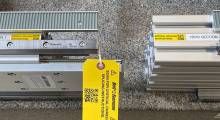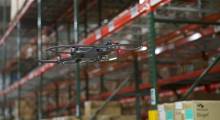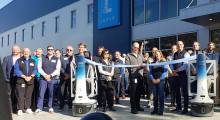Something is happening in the world of materials handling automation. Just look at the numbers. While the industry has not yet recovered to its pre-recession peaks, both the conveyor and automatic guided vehicle (AGV) sectors posted impressive year-over-year growth numbers. In fact, the Material Handling Industry of America (MHIA) is anticipating 12 percent growth in 2012.
But it’s not just the numbers. Mainstream business publications, like the Wall Street Journal, have written stories about automation projects at a Sunny Delight beverage plant in Massachusetts and a Stihl chainsaw factory in Newport News, Va. AT&T has run a national commercial highlighting lift trucks that operate without drivers.
What’s behind the interest in automation? And, what might the future of automation look like based on the products and solutions in development today? To find out, we posed those two questions to 10 leading materials handling automation and integrated systems suppliers. Here’s what they had to say.
Moving toward lights-out automation
Manufacturing has been moving toward lights-out automation for years—that’s a factory that operates with minimal human intervention. Distribution systems are now moving in that direction as well, says Ross Halket, director of automated systems for Schaefer Systems International.
“We are implementing systems where pallets are automatically put away into storage and are then de-layered, singulated, and stacked in sequence on a pallet that is then transported to a place where it will be picked up by a lift truck,” says Halket. “With piece picking, we are working on vision-guided robots.” Schaefer only has two piece-picking robotic systems running, he adds, but it is working with partners to refine the technology.
Goods-to-Person Order Fulfillment: The Multi-Channel Retailing Effect
Thursday, June 28, 2012 | 12 PM ET
Register for this FREE virtual conference session to learn Which methods leading retailers are using to address new sales channels.
Halket believes at least four trends are behind the demand for more complex, automated solutions.
The first is that the cost of automation has come down, putting it in reach of more end users. “In the wholesale pharmaceuticals industry, a company automated when they reached $1 billion a year in sales or 25,000 lines picked a day,” Halket says. “Today, that industry can justify automation with $500 million in sales and 14,000 lines a day.”
The second is the variability of the workforce. “In places like Calgary, Edmonton and Alberta, everyone goes to work in the oil fields when the price of oil goes past $100 a barrel,” Halket says. “Automation is being used in places like that to stabilize the workforce.”
A third is the absolute need for accuracy. “The cost of handling an inaccurate order is pretty high,” Halket says. “If you ship 13,000 cartons a day with a 94 percent accuracy rate, you’re re-handling about 780 cartons a day because of mistakes. That’s pretty expensive.”
Finally, it’s about space. “Just finding space close to a major urban area is pretty hard these days if you need to put down a 1-million-square-foot warehouse,” he says. “A compressed footprint is a greener facility.”
Smaller and more frequent deliveries
Mike Khodl, vice president for solution development for Dematic North America, sees a market in which automation with a higher level of complexity as a normal part of the solution is increasing compared to where we were as recently as two to three years ago.
Like his competitors, Khodl attributes the interest in robotics, mini-load automated storage and retrieval systems and shuttles to the explosive demand for piece picking. And while e-commerce is a major character in that story, so is the demand for smaller and more frequent deliveries to store fronts, especially in urban areas.
“If a store is getting a pallet, it’s a mixed pallet. Instead of a case, it’s getting a tote with eaches. And they’re loading the trailer in the reverse order of the stops so they can sequence the deliveries,” says Khodl. That, he adds, assumes that a retailer is even sending out a full trailer. Increasingly, retailers are going to smaller trucks and vans because of congestion in urban areas. “All of that requires more touches in the distribution center, which means we have to find new ways to be more efficient to reduce costs,” says Khodl.
What will drive automation in the future? Khodl thinks urban congestion will play a major role. “By 2020, there will be 20 mega cities on the planet with 20 million people,” he says. “If Los Angeles, Cairo, New York, London, Frankfurt, Dubai, and Shanghai are all mega cities, how are we doing to do distribution into those cities?”
The answer, he adds, is that distribution will have to be space-saving, efficient, and use as little labor as possible. “We’ll have to put facilities near these cities, which means that land and labor is going to be expensive,” Khodl says. “And, in an e-commerce world, that’s going to mean more piece-picking solutions. I think we’re just seeing the tip of that iceberg.”
A technology renaissance
“The amount of automation being requested here in the U.S. is unprecedented,” says Larry Strayhorn, president of TGW Systems. “Our engineers question whether there are diminishing returns, but we’re being pushed by our customers to automate the last processes.”
What’s behind this technology renaissance? Strayhorn believes that it’s related to the pain of downsizing that accompanied the last recession. “The cost of labor has always been the most important factor in automation projects,” Strayhorn says. “But I don’t believe it’s just the current cost of labor. Instead, it’s the cost of going through labor cycles, including the negative press that goes along with downsizing. Automation is one more way to deal with the speeding up of the business cycle.”
As with other industry leaders, TGW is seeing an increasing demand for piece-picking solutions. “Our focus is on using shuttle and mini-load technologies to bring the material from buffer systems to a workstation in the right sequence to do the picking, or full automation to a robotic work cell to do the palletizing,” says Strayhorn. “Technologies that are able to operate at 1,000 cycles per hour out of one aisle and deliver products in the right sequence are enabling us to create the kinds of solutions that customers are looking for.”
Beyond better mechanical solutions, today’s automated materials handling solutions are all about the software. “Yes, you have to have these great mechanical systems,” he says.
“But in order to take advantage of the capabilities of the equipment, you have to have new levels of software. We’re investing heavily in our warehouse control and warehouse management software to keep pace with the mechanical technology.”
Look for more shuttles
“We have a saying at Knapp,” says Josef Mentzer, chief operating officer for Knapp USA. “OSR is the answer. What is the question?”
At Knapp, OSR stands for Order Storage and Retrieval. That’s the company’s moniker for systems that use mobile shuttles instead of mini-load cranes for the high-density storage of cartons, totes, and individual products weighing about 100 pounds or less.
As more and more end users focus on smaller deliveries and each picking, Mentzer believes the market for shuttles is poised for exponential growth. “We developed shuttle technology to optimize the storage and picking of slow moving items,” he says. “Today, we have 1,400 each-picking solutions in operation, using thousands of shuttles. Those shuttles are being used across industries, and they’re being adapted to buffering, shipping sortation, and work-in-process. It’s not just picking any longer.”
In addition to efficient processes, Mentzer says shuttles are sustainable, requiring about 5 percent of the electricity required to operate a mini-load automated storage and retrieval (AS/RS) and only about 20 percent of the electricity required for a carousel system.
They’re also capable of more cycles per hour in a smaller space than a mini-load. “A mini-load can typically do 100 to 150 double cycles per hour per aisle,” Mentzer says. “With a shuttle, I can do more than 700 cycles per hour per aisle. Basically, it takes four to five aisles of a mini-load to pull out the same number of items per hour as a shuttle.”
What’s next? Knapp is developing a vision-guided picking system as an alternative to RF- or voice-directed picking in conventional areas in the warehouse. “This is still an emerging solution,” says Mentzer. “But we believe it could change what we do in the warehouse and how we do it.”
Simplify automation, optimize operations
Daifuku Webb’s traditional customer base in North America has been manufacturing. In that space, manufacturers are changing their approach toward automation, says Ralph Mills, director of integrated systems. That is especially true of automatic guided vehicles (AGVs), as more manufacturers replace lift trucks and conveyors.
Mills attributes the renewed interest in AGVs in part to the introduction of the automatic guided cart, a stripped-down, lighter duty AGV that follows magnetic tape for navigation. “The automatic cart lowered the price of entry for AGV technology,” says Mills. “While magnetic tape was initially viewed as a step back, it simplified the creation of a guidepath. Move the tape, and the vehicle will follow it.” According to Mills, Daifuku Webb alone produced more than 600 automatic carts last year.
Although labor is the traditional justification for automation, Mills believes that material flow is emerging as an important consideration by companies considering automation.
“Customers are justifying automation within the four walls of the warehouse based on downstream labor savings,” Mills says. “If a food and beverage distributor can use AGVs to load a trailer in the delivery sequence and maximize the payload, that can deliver downstream savings that are far greater than the labor savings in the warehouse.”
Speed counts
In manufacturing work cells, where robots weld seams, install windshields, and load and unload machines, automation has been commonplace for years. Now, manufacturers are automating the processes between the work cells and doing so on a global basis, says Tom Meyers, national sales manager for Muratec. “We had 40 percent growth last year, and it was on a worldwide basis,” says Meyers. “China, for instance, was an area where we saw significant growth.”
Reducing labor has always been the traditional justification for automation in manufacturing, where the jobs are more costly because the skill level is higher. Today, there is also an emphasis on making things operate faster. “If I can increase the speed of the equipment, I can get more throughput and productivity from the equipment that I’m installing,” says Meyers. “Automated storage and retrieval cranes are running faster than before. And while AGVs are not traveling faster along their paths because of safety concerns, their response times for loading and unloading are faster than they used to be.”
Automated materials handling is also being applied in new ways on the manufacturing floor. Historically, AS/RS technology was installed in high-bay facilities that stored raw materials and parts or finished goods. “Now we’re putting in systems with fewer aisles and a 20-foot ceiling to handle work-in-process,” says Meyers. “We’re using AGVs instead of lift trucks and conveyors.”
More importantly, he adds, automation is allowing factories to operate two and three shifts a day without employing a three-shift workforce.
From pallets to cases to pieces
The world of materials handling is getting smaller, says Markus Schmidt, senior vice president for Swisslog. “The order that shipped as a pallet a few years ago is shipped as a case today and will be shipped as a piece tomorrow,” he says. “The quantities received at the store are smaller and more precise. This has a profound impact on the distribution center.”
By precise, Schmidt means that stores want to receive their deliveries packed and sequenced in a way that reduces the labor requirement in the stores. “If you can do something in the DC that allows you to replenish the shelf in the right sequence, you can operate a store with one or two less employees,” Schmidt says. “For a retailer with a thousand stores, that has a major impact. There’s no way to achieve that without technology.”
Those changes have opened the door for picking solutions that bring items to a workstation, such as multi-shuttles and mobile robotic solutions. “Kiva created a market for this type of entry-level, goods-to-person picking solution and we have a similar technology in our portfolio with the AutoStore,” says Schmidt.
Schmidt believes that the next horizon will be vision-guided, robotic piece-picking solutions and shuttles that can roam a facility to make a delivery. “Today, the shuttle delivers its load to a conveyor,” says Schmidt. “Tomorrow, I believe we’ll see the shuttle leave the racking and go where the conveyor would go. Think of it as a free-roaming shuttle solution.”
Balance in multi-channel retailing
When it comes to distribution, multi-channel retailing is creating challenges and opportunities for automated materials handling. “I think of it as store front and front door fulfillment,” says Jerry Koch, director of corporate marketing and product management for Intelligrated. “You want the right mix of equipment and software to make decisions at the speed of the automation to have a positive effect on the day.”
The approach being pursued by Intelligrated, says Koch, is to use warehouse management and warehouse control software to manage the release and flow of orders in a way that balances the work in the building. The system not only gets materials to the shipping dock efficiently, it distributes the work in a manner that keeps everyone busy without creating bottlenecks. If one area of the facility becomes too busy, the system can redirect the flow of material to another area that has capacity and it can make those decisions dynamically in real time.
Looking forward, Koch and Intelligrated expect to see breakthroughs in robotics, especially as vision technologies mature. “This is an area where there are a lot of conversations going on with customers,” says Koch. “The driver is the cost and availability of labor. We expect to see this continue to pick up steam.”
Integrating humans and automation
The appetite for automation in North America is game changing, says Kevin Ambrose, CEO of Wynright.
While there is talk in the industry about lights-out automation—systems that complete processes entirely with automated materials handling equipment and software—Ambrose believes that the next frontier is creating an environment where automated materials handling, robotics technology, and humans work hand-in-hand. He looks to Apple for the model.
“There is no dispute that Steve Jobs mastered the confluence of technology and humanity,” says Ambrose. “We believe that the software and the interfaces in materials handling systems need to be as simple and intuitive as an iPod.”
In addition to investments in software and robotics, Ambrose has recruited talent from industries outside of materials handling that can bring a different perspective to the products and solutions Wynright is developing.
“We want to take that mandate for simple and intuitive and apply it to the solutions we’re putting in distribution centers,” says Ambrose. “We want an environment where people feel comfortable working side by side with automation and robotics rather than have the materials handling equipment off in its own separate area.”
March of the robots
While most companies see an explosion in automation, Brian Keiger, global technology sales leader for Kuka Systems, takes a contrarian view. He expects to see a slow down in the move to automate, at least in the short run. That, he adds, may be a good thing.
“Twenty five tons of product are being picked per day in the average warehouse,” Keiger says. “In the past, a full pallet of product came in and a full pallet with maybe eight SKUs of product was shipped out. Today, we’re seeing pallets with eight SKUs per layer and the package types are outrageous.”
At the same time, he adds, the baby boomers with unique attitudes and skills are retiring. “The kids coming out of college don’t want to stand around and pick all day long,” he says. With those trends as a backdrop, companies are asking new questions about how they operate their facilities. Those questions are leading to the coming pause in automation.
“End users aren’t just looking at picking,” Keiger says. “They’re wondering if they should automate storage or if they should automate the movement of goods. As they get more thoughtful, they’re slowing down their purchases of automation—at least temporarily.”
Just as the end user community is looking beyond automated solutions for picking, so is Kuka Systems. “We’re looking at total warehouse solutions,” Keiger says. “We’re developing solutions that can handle everything from a 2-inch by 2-inch box up to a 48-inch by 48-inch box. And, we’re launching a mobile robot that can move a load weighing up to 3,500 pounds.”
About the Author
Follow Robotics 24/7 on Linkedin
About the Author
Follow Robotics 24/7 on Linkedin
Article topics
Email Sign Up
















